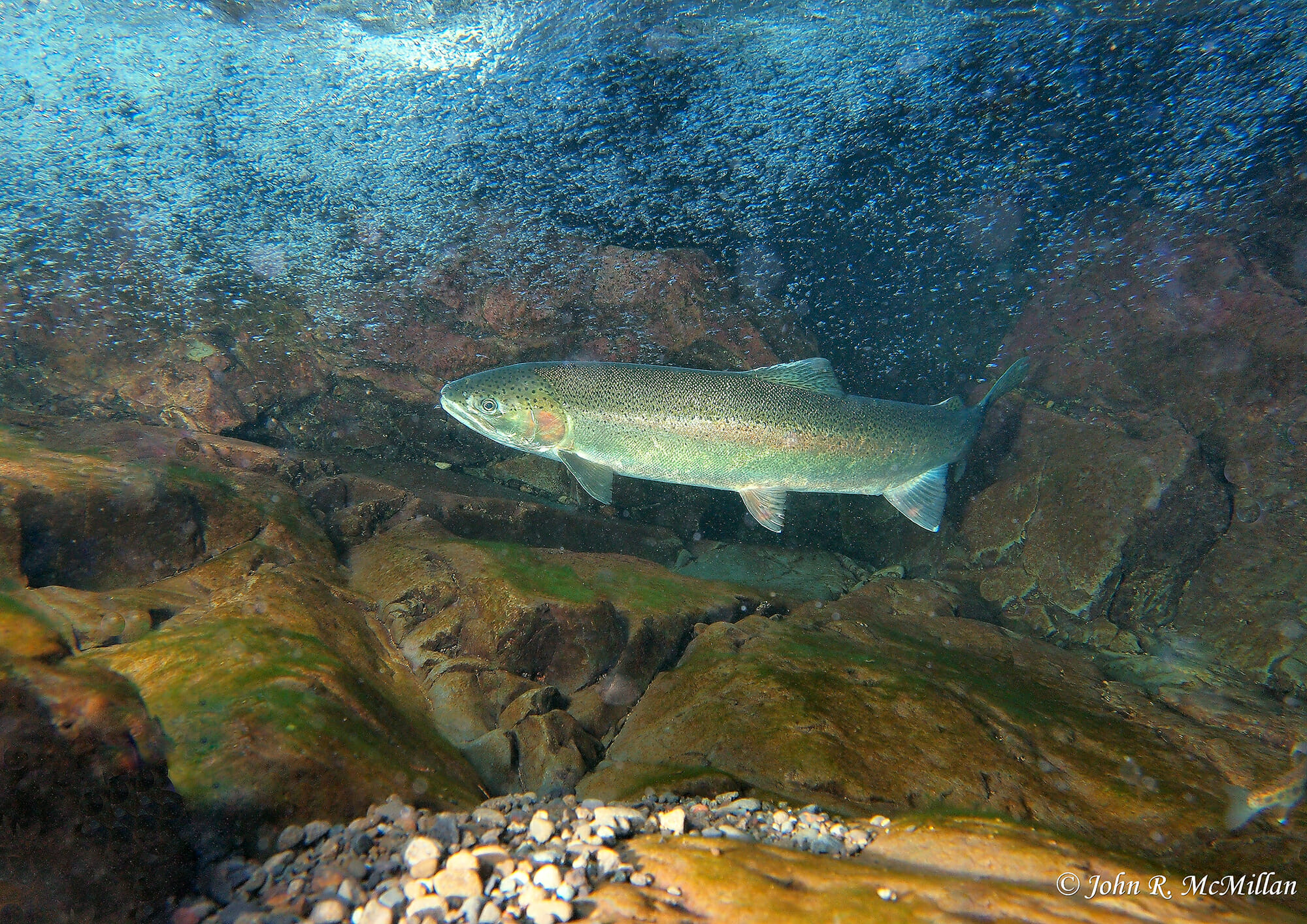Editors note: Every Friday, our science junkies over at Trout Unlimited’s Wild Steelhead Initiative give us an inside look at what’s happening in the world of steelhead science. During the Holidays, we’re running the best of those Science Friday piec
es on the TU blog. If you’ve ever spent any time thinking about the sheer game of chance involved in the life-cycle of a wild steelhead, you know this is a world filled with drama, wonder, and downright crazy stuff. And at TU no one knows it better than our science experts. Here are a few of our favorite posts from 2017.
Want more? Follow along at wildsteelheaders.org.
By John McMillan
Originally published September 2017
A few years back, while working on the Elwha dam removal project, I donned a wetsuit for one of many snorkel surveys I conducted that summer. I had been snorkeling the main-stem Elwha, but that day – a crisp cool day in mid-October – I found myself drawn to a small tributary, a stream that I and other scientists regularly monitored for salmon and steelhead.
Why should I snorkel the tributary that day? It felt like steelhead season. Fallen maple and alder leaves covered the streambank. October caddis, too numerous to count, dipped and fluttered under the canopy of alders. The river was cold and clear. The only thing missing was steelhead.
The Elwha River historically supported both summer and winter steelhead. On occasion I and other biologists would spot an adult summer steelhead in the lower Elwha prior to removal of the dams. Never did we see more than one or two fish a year, though, and we saw none in some years. In contrast, there were around 100-300 wild winter runs in the system. So we frequently observed them.
I was present for the first observation of adult winter steelhead returning above the dam. That was an experience I will not soon forget — the appearance of a large male with rounded shoulders and a double red stripe. But, on that October day of snorkel surveying, I really wanted to find a summer run, if only because they were rarer.
I did not find any summer steelhead that day. Yet the breath of fall continued for another few weeks. Exactly the type of conditions that inspire a bit more exploration. I found bull trout, which was cool. But no steelhead.
Soon the first rains of fall arrived, which I thought ended any chance at finding a summer run. The stream dropped quickly, however, and on a drizzly day a mile up its canyon I dipped my head into a plunge pool. Glory! A hen summer run held beneath the bubble curtain.
 src=”http://www.tu.org/wp-content/uploads/2018/12/IMG_2525.jpg” />She was perhaps 27” long, with blushed cheeks and a rosy side. I surmised she had been in the river for at least a couple months. I lifted my camera and snapped several photos before she turned and swam downstream, over the crest of the tailout before disappearing down into a series of cascades.
src=”http://www.tu.org/wp-content/uploads/2018/12/IMG_2525.jpg” />She was perhaps 27” long, with blushed cheeks and a rosy side. I surmised she had been in the river for at least a couple months. I lifted my camera and snapped several photos before she turned and swam downstream, over the crest of the tailout before disappearing down into a series of cascades.
A day or so later and the stream was brown and high. Fall rains swamped the area, and likely washed out any chance of finding additional summer runs. I had gotten lucky. One last survey, the final at-bat with two outs, two strikes and one man on, with the game on the line. I will carry that memory to my deathbed.
Since that initial observation a few years ago, biologists have documented other summer steelhead in the Elwha, all with intact adipose fins. In fact, last summer biologists with Olympic National Park – including Heidi Hugunin and James Starr – spotted a handful of summer steelhead several miles above the former Glines Canyon Dam. They also found sockeye and Chinook. Still, it is the summer runs that are most exciting for steelheaders.
While this summer has been a disappointment for summer run fishing across much of the Pacific Northwest, it has also brought reason for optimism. Just this week I observed two more wild summer steelhead in the Elwha River. Both were male and each had an adipose fin. With any luck surveys will find additional steelhead above Glines Canyon, as they did last year.
The Elwha is still recovering and it is unlikely there are yet many summer steelhead in the basin. Nonetheless, these fish have started to return, started to recolonize habitats not occupied by anadromous Mykiss for over 100 years. As my friend Dr. Tom Quinn says, “There has been a reawakening of anadromy.”
It will be interesting to see what the genetics reveal about summer steelhead in the Elwha. Are they strays from other populations? Did a very small number of fish native to that basin somehow hold on below the dams for decades? (This seems unlikely.) Or maybe, like the Phoenix rising from the ashes, they are the progeny of resident rainbow trout that have been long isolated above the dams? All we know for sure right now is that summer runs are once again using the middle and upper Elwha.
Monitoring and sampling efforts will likely reveal the source of these fish in the coming years. Some information about them may even come sooner. But it may take much longer to determine whether the population will become fully independent and self-sustaining. I have my fingers crossed. Given the resilience of steelhead, however, I am not sure they need this kind of help. All they need is some cool clean water and unfettered access to headwaters with high quality habitat.That, the Elwha has in spades.
 Trout Unlimited’s Wild Steelhead Initiative and associated advocacy group, Wild Steelheaders United is an ambitious and hopeful effort to protect and restore wild steelhead. Today, 70 percent of the major steelhead populations in Oregon, Idaho, Washington and California require federal protection and opportunities to catch wild steelhead have diminished dramatically in many rivers. For more information, go to wildsteelheaders.org or join us on Facebook and Instagram.
Trout Unlimited’s Wild Steelhead Initiative and associated advocacy group, Wild Steelheaders United is an ambitious and hopeful effort to protect and restore wild steelhead. Today, 70 percent of the major steelhead populations in Oregon, Idaho, Washington and California require federal protection and opportunities to catch wild steelhead have diminished dramatically in many rivers. For more information, go to wildsteelheaders.org or join us on Facebook and Instagram.



